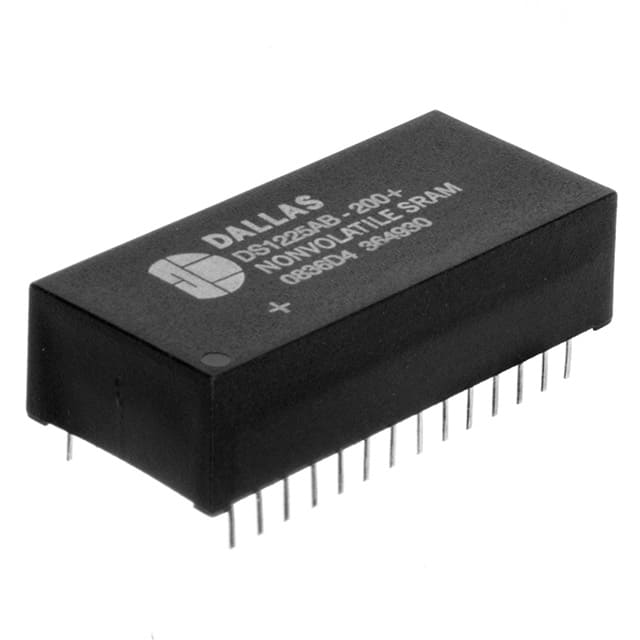Lihat spesifikasi untuk detail produk.

DS1230Y-200IND+ - English Editing Encyclopedia Entry
Product Overview
Category
The DS1230Y-200IND+ belongs to the category of non-volatile static RAM (NVSRAM).
Use
This product is commonly used as a memory device in various electronic systems and applications.
Characteristics
- Non-volatile: The DS1230Y-200IND+ retains data even when power is disconnected.
- Static RAM: It provides fast read and write access times.
- High density: The DS1230Y-200IND+ offers a large storage capacity.
- Low power consumption: It operates efficiently, minimizing energy usage.
Package
The DS1230Y-200IND+ is available in a compact and durable package, ensuring easy integration into electronic circuits.
Essence
The essence of the DS1230Y-200IND+ lies in its ability to combine the benefits of non-volatile memory with the speed and efficiency of static RAM.
Packaging/Quantity
The DS1230Y-200IND+ is typically packaged individually or in reels, depending on the manufacturer's specifications. The quantity per package may vary.
Specifications
- Model: DS1230Y-200IND+
- Memory Capacity: 2 Megabits (256K x 8)
- Access Time: 200 nanoseconds
- Supply Voltage: 4.5V to 5.5V
- Operating Temperature Range: -40°C to +85°C
- Data Retention: Minimum 10 years
Detailed Pin Configuration
The DS1230Y-200IND+ has the following pin configuration:
- Chip Enable (/CE)
- Output Enable (/OE)
- Write Enable (/WE)
- Address Inputs (A0-A17)
- Data Inputs/Outputs (DQ0-DQ7)
- Ground (GND)
- 5V Power Supply (VCC)
Functional Features
- Non-volatile data storage
- Fast read and write access times
- Low power consumption
- High data retention period
- Easy integration into electronic systems
Advantages and Disadvantages
Advantages
- Retains data even during power loss
- Provides fast and efficient memory access
- Suitable for a wide range of applications
- Compact and durable packaging
Disadvantages
- Relatively higher cost compared to traditional RAM
- Limited storage capacity compared to other non-volatile memory options
Working Principles
The DS1230Y-200IND+ utilizes a combination of volatile and non-volatile memory technologies. It employs static RAM cells for fast read and write operations, while incorporating non-volatile elements to retain data even when power is disconnected. This is achieved through the use of a built-in energy source, such as a battery or an integrated capacitor.
Detailed Application Field Plans
The DS1230Y-200IND+ finds application in various fields, including but not limited to: 1. Industrial automation systems 2. Automotive electronics 3. Medical devices 4. Communication equipment 5. Consumer electronics
Detailed and Complete Alternative Models
- DS1230AB-200IND+
- DS1230Y-150IND+
- DS1230Y-250IND+
- DS1230Y-200IND
- DS1230Y-200IND++
These alternative models offer similar functionality and characteristics to the DS1230Y-200IND+, providing users with options based on their specific requirements.
In conclusion, the DS1230Y-200IND+ is a non-volatile static RAM that combines the benefits of non-volatile memory with the speed and efficiency of static RAM. With its high density, low power consumption, and long data retention period, it is suitable for a wide range of applications in various industries.
Sebutkan 10 pertanyaan dan jawaban umum terkait penerapan DS1230Y-200IND+ dalam solusi teknis
Question: What is the DS1230Y-200IND+?
Answer: The DS1230Y-200IND+ is a non-volatile static RAM (NVSRAM) integrated circuit that combines the benefits of both RAM and non-volatile memory.Question: What are the key features of the DS1230Y-200IND+?
Answer: The key features of the DS1230Y-200IND+ include a 32K (4K x 8) NVSRAM, battery backup support, unlimited write cycles, and a wide operating voltage range.Question: How can the DS1230Y-200IND+ be used in technical solutions?
Answer: The DS1230Y-200IND+ can be used as a reliable data storage solution in applications where data needs to be retained even during power loss or system shutdowns.Question: Can the DS1230Y-200IND+ be used in battery-powered devices?
Answer: Yes, the DS1230Y-200IND+ is designed to operate with a wide voltage range, making it suitable for use in battery-powered devices.Question: Does the DS1230Y-200IND+ require any external components for operation?
Answer: No, the DS1230Y-200IND+ does not require any external components for basic operation. However, an optional battery backup circuit can be added for data retention during power loss.Question: What is the maximum data retention period of the DS1230Y-200IND+?
Answer: The DS1230Y-200IND+ has a minimum data retention period of 10 years, ensuring long-term reliability of stored data.Question: Can the DS1230Y-200IND+ be easily integrated into existing systems?
Answer: Yes, the DS1230Y-200IND+ is available in a standard 28-pin DIP package, making it compatible with most existing systems and easy to integrate.Question: Is the DS1230Y-200IND+ compatible with common microcontrollers or microprocessors?
Answer: Yes, the DS1230Y-200IND+ can be easily interfaced with common microcontrollers or microprocessors using standard parallel interface protocols.Question: Can the DS1230Y-200IND+ be used in industrial applications?
Answer: Yes, the DS1230Y-200IND+ is designed to meet industrial temperature range specifications, making it suitable for use in various industrial applications.Question: Are there any limitations or considerations when using the DS1230Y-200IND+?
Answer: One consideration is that the DS1230Y-200IND+ has a limited write endurance of 10,000 cycles, so it may not be suitable for applications with frequent write operations. Additionally, proper power management and battery backup circuitry should be implemented to ensure data integrity during power loss.

